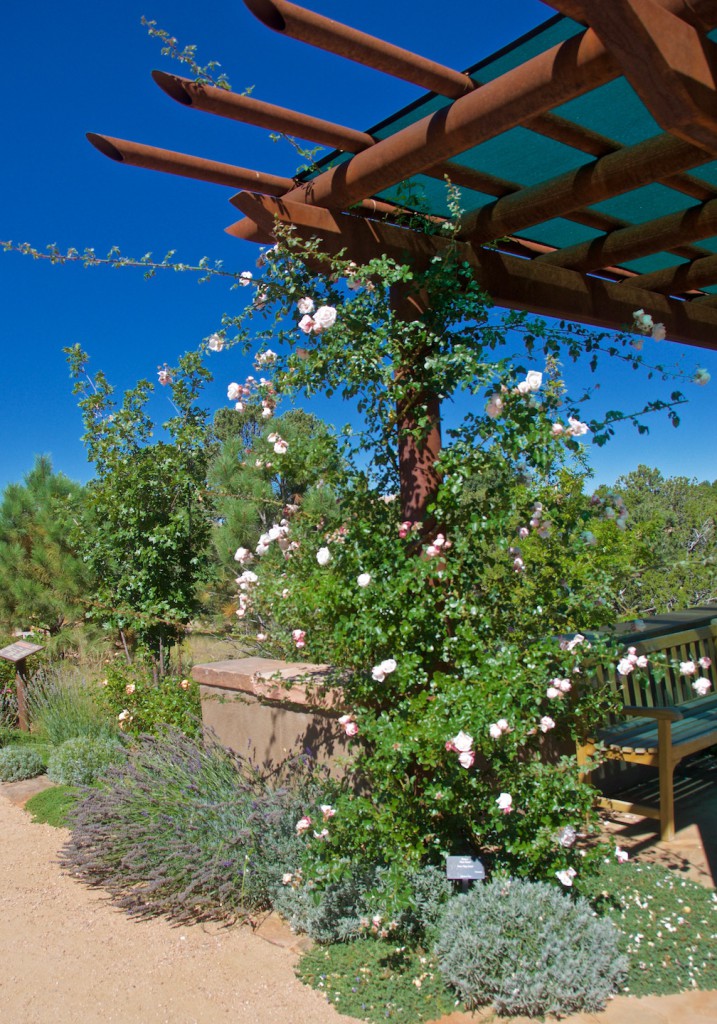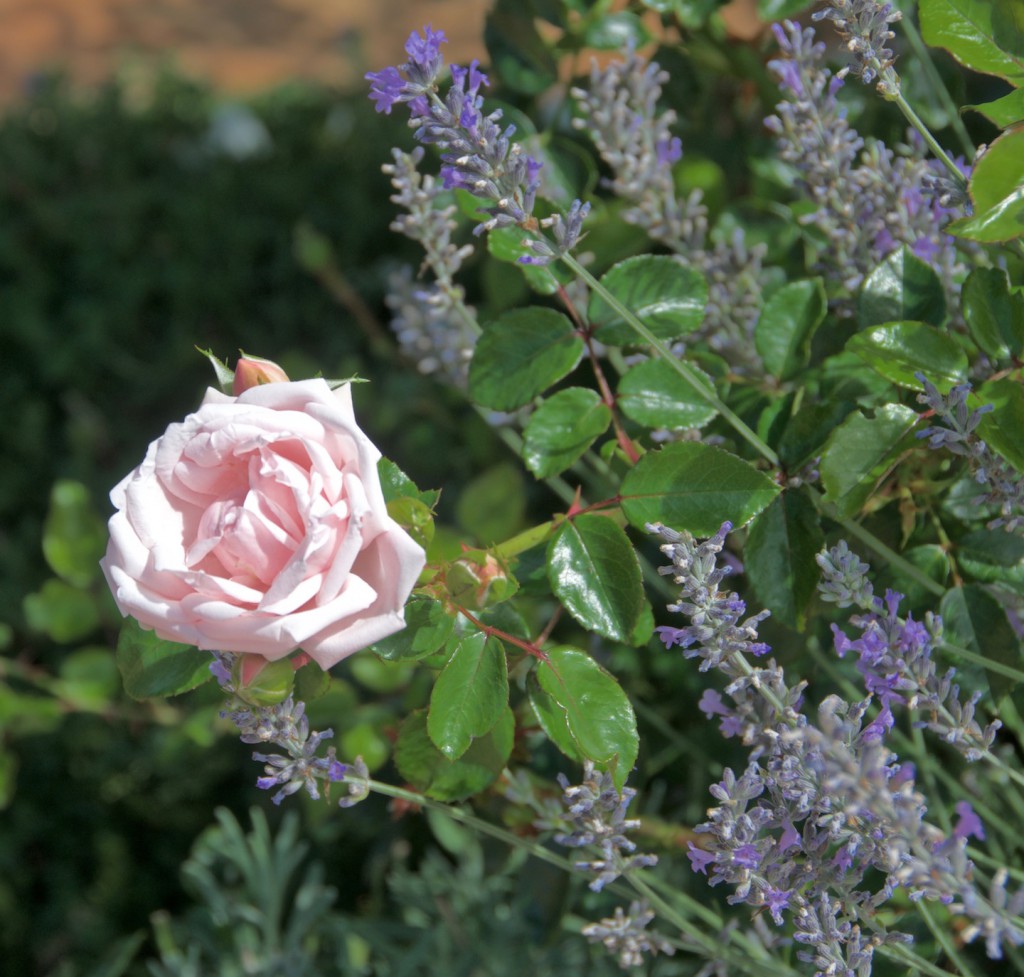Scientific name: Rosa × ‘New Dawn’

Rosa x ‘New Dawn’ (Photo: Janice Tucker)
Common name: ‘New Dawn’ climbing rose
Family: Rosaceae
by Jeanne Gozigian
The story of ‘New Dawn’ and other rose cultivars is as interesting as the biographies of celebrities and royalty. History and the study of plant genetics contribute to the understanding of this lovely addition to the roses of the Botanical Garden at Museum Hill. The silvery pink climber with bright green, pinnate leaves and thorny stems has a prominent place on the front posts of the North Ramada after entering the Garden. It is a robust climber, twining its beautiful way to the top of the uprights in the first season after planting.
It is an easy keeper, preferring full sun and well drained, fertile soil but tolerant of partial shade and less ideal soil types. It does not mind being north facing and is hardy in zones 4b-9. Balanced fertilizer and an application of mulch in the early spring, followed by another in early summer, keep it happy and healthy. The fragrant double blossoms are remontant; that is, they bloom more than once a season, providing garden beauty throughout the growing period. It is subject to aphid attack, as are most roses, and powdery mildew. It can be propagated by hardwood cuttings.
How did ‘New Dawn’ come to be one of the most popular climbing or rambling roses for gardeners? We must look to her history for the answer. Part of her biography (I am not sure if I should assign a gender to ‘New Dawn’; I just feel that her pale pink beauty justifies her femininity!) is best explained by reviewing the binomial system of plant names.
The 18th century botanist, Carl Linnaeus, developed the word system using the universal language of scholars and scientists, Latin, because common names were deceiving and confusing. Botanists around the world could be certain that they were discussing the same plants. But, unlike classical Latin, “botanical latin” is borrowed from Greek and other languages. In 1962, the International Code of Botanical Nomenclature (ICBN) took on the role of determining plant names and changes in classifications, with which amateur botanists continue to struggle. Modern science, including DNA analysis, makes reclassification inevitable.
Thus: Our featured rose is known as:
Family: Rosaceae
Genus: Rosa (in italics)
Specific epithet: in lower case italics, e.g. Rosa rubiginosa. But because our featured rose is a hybrid and a cultivar, it is written as Rosa × “New Dawn” an × sign (in lower case and not italicized), indicating that she is a cultivar and her name in single quotation marks, ‘New Dawn’, in upper and lower case Roman type.
It is thought that most of the modern (after 1900) climbers owe most of their genealogy to a handful of wild, climbing species, mostly from China. Perhaps they were cultivated, 5,000 years ago, for their edible properties. The young tips of Rosa canina (dog rose) can be edible, and the use of rose hips to obtain vitamin C is well documented.
Max Ernst Wichura (1817-1866), was a scientist who was an expert on the willow genus, Salix. In 1859 he became interested in naturally occurring hybrids, along with Charles Darwin and Gregor Mandel. Rosa wichuraiana is named after him, as is the subgenus, Wichureae. R. wichuraiana is one of the ancestors of ‘New Dawn’, whose “chance birth” in 1930 came as a sport from ‘Dr. W. Van Fleet’. She has proved to be the best ever remontant, climbing rose. Many of the roses developed from ‘New Dawn’ crosses share her profuse flowering while featuring different colors. ‘Bantry Bay’, ‘New Dawn’ × ‘Korona’ is a deeper pink; ‘Coral Dawn’, ‘New Dawn’ × unnamed yellow hybrid tea has a lovely apricot color; and ‘New Dawn Rouge’, ‘New Dawn’ × seedling is a brilliant red.

Rosa x ‘New Dawn’ (Photo: Janice Tucker)
These roses are not true climbers in that they must have support. They climb more effectively if they are first trained to grow horizontally, then vertically. Their canes are very pliable and not too thorny, lending themselves to easy training up posts and trellises. The roses that have come from R. wichuraiana are very hardy, healthy, and easy to grow. To continue the confusion created by taxonomists, the Missouri Botanical Garden’s, “The Plant List” says that R. wichuraiana is now a synonym for Rosa lucieae. I prefer to think of her as a child of the great Max Ernst Wichura! ‘New Dawn’, by any name, with her 3” pale pink blossoms, will reach 9’ quickly and fill a modest sized trellis around a doorway to the great satisfaction of a neophyte gardener.
Special thanks to:
Scott Canning, Director of Horticulture and Special Projects, and Linda Churchill, Head Gardener at the Museum Hill Garden, for their advice and guidance. Janice Tucker for her photos of ‘New Dawn’. Helen Woody and Janice Tucker for proofreading this article.
Sources:
Classic Roses, Peter Beales
Latin for Gardeners, Lorraine Harrison
Right Rose, Right Place, Peter Schneider
Royal Horticulture Society, https://www.rhs.org.uk
The Plant Book, an Encyclopedia of Worlwide Flora, consultants Geoff Bryant, Tony Rodd, Barbara Segall, R.G. Turner, Jr., and Ernie Wasson
The Plant List, http://www.theplantlist.org/
Wikipedia


